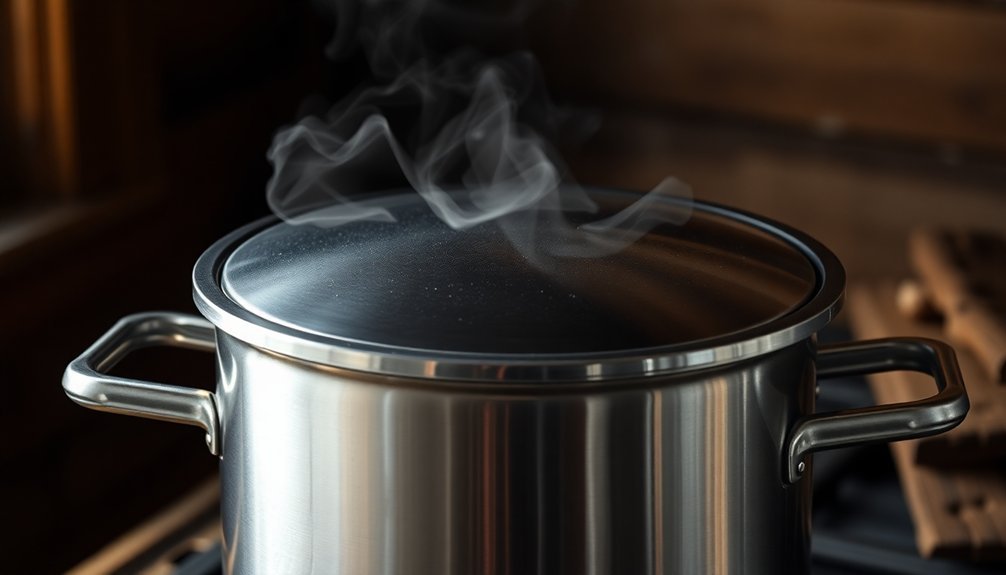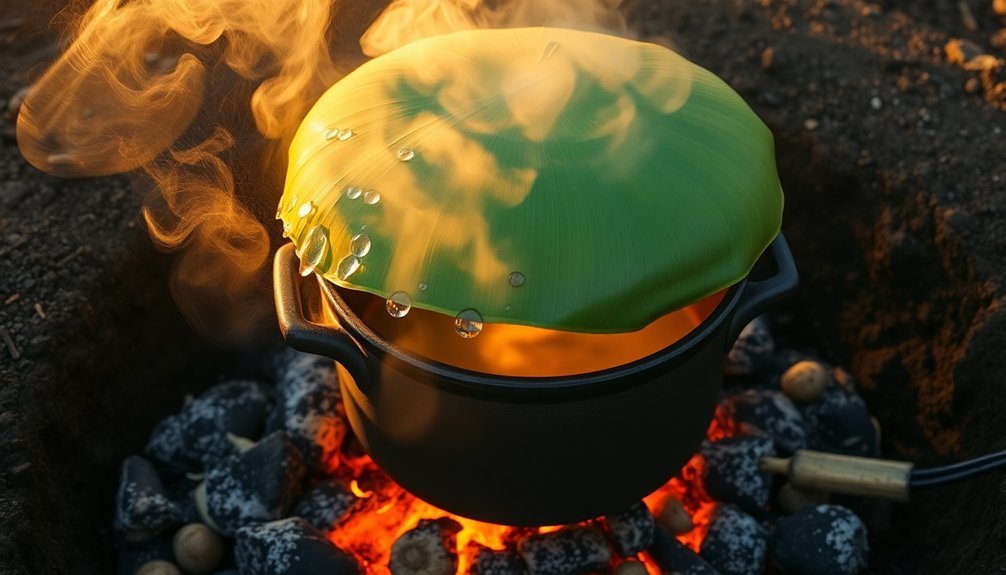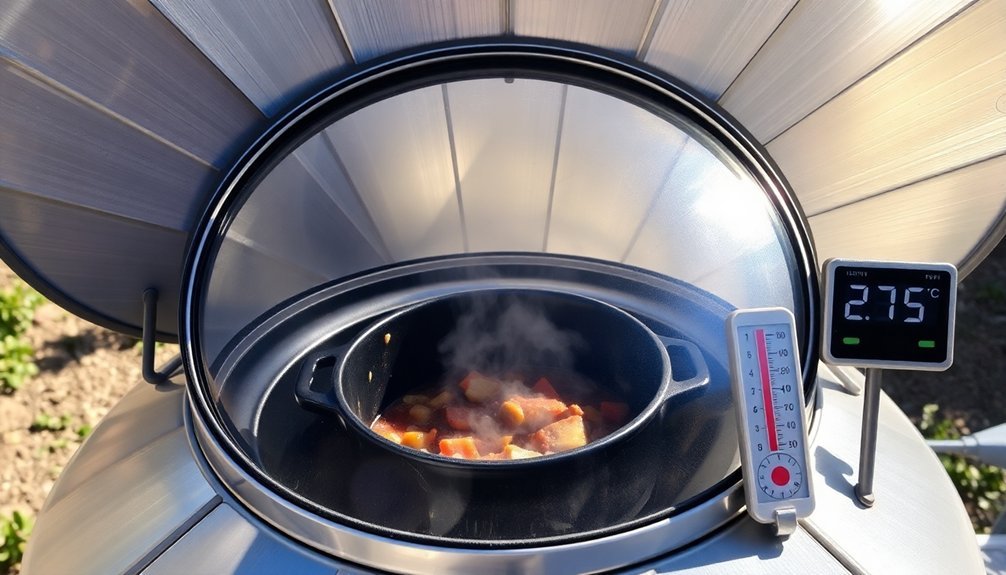Master steam management in your off-grid kitchen with these seven resource-saving tricks. Start by creating a perfect seal using tight-fitting lids and kitchen towels to prevent steam escape. Implement a double-layer lid system to capture and recycle moisture back onto your food. Time your steam releases strategically – early for bread, late for meats. Control moisture levels using natural desiccants and low-energy systems. Maximize water efficiency by cooking multiple ingredients in one pot and reusing cooking water. Position your cooking setup to optimize steam circulation, and employ heat-driven moisture control for consistent results. These techniques will transform your off-grid cooking experience.
Perfect Steam Sealing Techniques

When cooking off-grid, mastering proper steam sealing techniques can make the difference between perfectly cooked meals and wasted energy.
To create an effective seal, make certain your steamer basket fits snugly inside your pot, leaving minimal gaps for steam to escape. You'll want to cover the pot with a tight-fitting lid and consider wrapping it with a clean kitchen towel to trap more steam.
For improvised setups, you can create a seal by placing a heavy plate on top of your bamboo basket or using aluminum foil to cover any gaps. Having lightweight cookware on hand makes this process much more manageable when traveling to remote locations.
Don't forget to arrange your ingredients in a single layer to allow steam circulation, and if you're using multiple tiers, place foods requiring longer cooking times on the bottom level.
Keep monitoring water levels to maintain consistent steaming throughout the cooking process.
Sun-Powered Moisture Lock Methods
Solar-powered moisture retention combines ancient wisdom with modern technology to maximize your off-grid cooking efficiency.
You'll find that harnessing the sun's energy through a two-stage process helps lock in valuable steam during your outdoor meal preparation.
You can adapt zeolite-based moisture capture techniques to your cooking setup. This microporous material traps steam during the cooler evening hours and releases it when the sun heats up your cooking area.
It's remarkably effective even in conditions with just 20% humidity, unlike traditional methods that need higher moisture levels.
To implement this approach, position your cooking vessels to capitalize on natural temperature differences throughout the day. This innovative setup can generate up to 6 liters per hour in controlled conditions.
You'll double your steam retention by incorporating heat-recycling principles, making every drop of moisture count in your off-grid culinary adventures.
Double-Layer Lid Steam Capture

You'll greatly boost your off-grid cooking efficiency by using a double-layer lid system that combines your steamer's regular lid with a fitted piece of aluminum foil.
The extra barrier helps trap escaped steam and moisture above your food, creating a more concentrated cooking environment that preserves precious water resources.
This method works especially well when you're dealing with limited water supplies, as the captured condensation naturally drips back onto your food instead of escaping into the air. For optimal results, ensure there's space between food and the lid setup to allow proper steam circulation.
Capturing Lost Heat Above
Double-layer steaming systems offer a smart way to capture lost heat that would otherwise escape from your cooking setup. By stacking multiple layers, you'll maximize the steam's efficiency while cooking different foods simultaneously.
Your domed lid plays an essential role in keeping the heat contained and circulating properly.
You'll want to make sure your steamer's material supports effective heat conductivity. Bamboo steamers excel at managing condensation, while silicone options provide lasting durability.
To maintain ideal steaming conditions, keep an eye on your water levels and adjust the heat as needed. Don't forget to use perforated liners to help the steam reach your food evenly.
With proper steam capture, you'll get consistent cooking results while conserving energy – a fundamental consideration for off-grid meal preparation.
Extra Moisture While Cooking
While traditional steaming methods often lose precious moisture, a double-layer lid setup can dramatically improve your steam retention.
By combining a well-fitted domed lid with a bamboo steamer layer, you'll create an efficient moisture-trapping system that prevents water from dripping back onto your food. This setup works especially well when you're cooking items that require longer steaming times, like whole fish or sticky rice.
- Place your steaming rack at the bottom, ensuring there's enough clearance for proper steam circulation around your food.
- Add a perforated liner between layers to maintain even steam distribution while preventing food from sticking.
- Monitor your water levels regularly and maintain a consistent boil to keep the steam flowing – this is essential for off-grid cooking where resources are limited.
Foil Lid Combo Benefits
A foil lid combo takes steam retention to the next level, offering both flexibility and superior moisture control for off-grid cooking.
You'll create a tight seal by wrapping your ingredients in heavy-duty aluminum foil, trapping essential juices and flavors within the packet.
This method works perfectly for both campfire and pressure cooker settings.
Timing Your Steam Release
Since timing your steam release can make or break a dish, mastering this essential skill will greatly impact your off-grid cooking results.
You'll maximize energy efficiency and achieve better textures by controlling when and how you release steam during cooking.
For meats, you'll want to inject steam toward the end of cooking, which eliminates basting and keeps your proteins juicier.
When baking bread, use steam in the first 5-10 minutes to create that perfect crunchy crust you're after.
- Let pressure-cooked foods release steam naturally for the best texture, unless your recipe specifically calls for quick release
- Time your steam releases to avoid wasting precious energy in your off-grid setup
- Use the first 5-10 minutes of baking time for steam when making breads, soufflés, or starchy dishes
Water Management During Cooking

Managing your water resources effectively lies at the heart of successful off-grid cooking. You'll want to establish reliable sources through rainwater collection systems or well water, guaranteeing proper storage in large tanks and regular quality testing.
During meal preparation, make your water work harder by using a single pot for multiple ingredients. Start with lighter-flavored foods first, then progress to stronger ones. You can cook pasta in less water than traditionally called for, and don't forget to collect and reuse cooking water when possible.
Install a quality filtration system like a Berkey filter to guarantee your cooking water is safe, and consider implementing solar-powered pumps or gravity-fed systems for reliable water distribution.
Maintain your equipment regularly, checking for leaks and replacing filters as needed.
Steam Circulation Sweet Spots
Beyond water management, proper steam circulation can maximize your off-grid cooking efficiency.
You'll want to find the sweet spots where steam flows effectively through your cooking setup. This means positioning your pots and steam vents to create an efficient heat transfer path while preventing pressure buildup.
- Set your cookware at the ideal height above your heat source – typically 4-6 inches for most wood-burning setups – to capture the most efficient steam flow.
- Position steam vents away from direct drafts to maintain consistent circulation and prevent heat loss.
- Create a balanced system by matching your pot size to your stove's capacity, ensuring you're not overwhelming or underwhelming your heat source.
Remember to monitor pressure points and maintain clear airflow paths to keep your steam circulation system running smoothly and safely.
Heat-Driven Moisture Control

While cooking off-grid requires careful steam management, controlling moisture levels is equally essential for food quality and safety.
You'll want to harness heat-driven moisture control systems that use desiccants like silica gel or zeolite to regulate humidity. These systems work efficiently with low-quality heat sources, such as 55°C hot water, consuming only 2-3 kW per unit.
You can customize your setup with adjustable vents to release excess moisture from foods that naturally emit steam. Whether you're proofing dough or storing prepared dishes, precise humidity control helps prevent mold and maintains food quality.
The best part? You don't need much electrical power – just enough to run auxiliary equipment like fans. For peak efficiency, position your heating elements strategically to guarantee quick recovery to ideal moisture levels.
Frequently Asked Questions
Can Different Solar Ovens Be Stacked to Maximize Steam Retention?
You can stack solar ovens vertically, but you'll need proper insulation between units to prevent heat loss. It's best to use compatible designs that allow steam to flow upward through connected chambers.
How Do Altitude Changes Affect Steam-Based Cooking Times Off-Grid?
You'll need to increase cooking times considerably at higher altitudes, since water boils at lower temperatures. For every 500-ft elevation gain, add about 5% more time to account for reduced steam efficiency.
What Materials Make the Best DIY Steam-Catching Lids?
For DIY steam-catching lids, you'll want to use stainless steel as your primary material. It won't warp at high temperatures, resists corrosion, and creates a reliable seal. Avoid glass, aluminum, or copper alternatives.
Does Steam Retention Vary Between Morning and Afternoon Solar Cooking?
Yes, you'll notice better steam retention in afternoon solar cooking due to higher temperatures and more intense sunlight. Morning cooking requires extra insulation and tighter-fitting lids to maintain steam levels effectively.
Can Retained Steam Cooking Work Effectively in Humid Climates?
Yes, you'll find steam cooking works well in humid climates. Higher ambient humidity actually helps maintain moisture in your food, reduces steam loss, and improves heat transfer efficiency. It's an ideal environment for steam cooking.
In Summary
You'll find these steam-saving techniques transform your off-grid cooking experience. By implementing proper sealing, sun power, and strategic moisture control, you're not just conserving precious water – you're enhancing flavor and efficiency. Whether you're using double-layer lids or timing your steam release perfectly, these methods guarantee your meals come out perfectly cooked while minimizing resource waste in your off-grid kitchen.





Leave a Reply